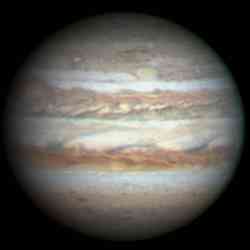
Red spots on Jupiter. Image credit: Christopher Go. Click to enlarge
If you’re an amateur astronomer with a reasonably good telescope, you might be able to see a new red spot on Jupiter. Its official name is Oval BA, and it’s half the size the of the famous Great Red Spot. It first appeared in 2000 when three smaller storms collided and merged together. It started out white, then changed to brown, and now it’s the same colour as the Great Red Spot. It’s possible that huge storms like this dredge material from deep beneath Jupiter’s cloud tops, and then ultraviolet light from the Sun changes it red.
Backyard astronomers, grab your telescopes. Jupiter is growing a new red spot.
Christopher Go of the Philippines photographed it on February 27th using an 11-inch telescope and a CCD camera:
The official name of this storm is “Oval BA,” but “Red Jr.” might be better. It’s about half the size of the famous Great Red Spot and almost exactly the same color.
Oval BA first appeared in the year 2000 when three smaller spots collided and merged. Using Hubble and other telescopes, astronomers watched with great interest. A similar merger centuries ago may have created the original Great Red Spot, a storm twice as wide as our planet and at least 300 years old.
At first, Oval BA remained white?the same color as the storms that combined to create it. But in recent months, things began to change:
“The oval was white in November 2005, it slowly turned brown in December 2005, and red a few weeks ago,” reports Go. “Now it is the same color as the Great Red Spot!”
“Wow!” says Dr. Glenn Orton, an astronomer at JPL who specializes in studies of storms on Jupiter and other giant planets. “This is convincing. We’ve been monitoring Jupiter for years to see if Oval BA would turn red – and it finally seems to be happening.” (Red Jr? Orton prefers “the not-so-Great Red Spot.”)
Why red?
Curiously, no one knows precisely why the Great Red Spot itself is red. A favorite idea is that the storm dredges material from deep beneath Jupiter’s cloudtops and lifts it to high altitudes where solar ultraviolet radiation–via some unknown chemical reaction?produces the familiar brick color.
“The Great Red Spot is the most powerful storm on Jupiter, indeed, in the whole solar system,” says Orton. The top of the storm rises 8 km above surrounding clouds. “It takes a powerful storm to lift material so high,” he adds.
Oval BA may have strengthened enough to do the same. Like the Great Red Spot, Red Jr. may be lifting material above the clouds where solar ultraviolet rays turn “chromophores” (color-changing compounds) red. If so, the deepening red is a sign that the storm is intensifying.
“Some of Jupiter’s white ovals have appeared slightly reddish before, for example in late 1999, but not often and not for long,” says Dr. John Rogers, author of the book “Jupiter: The Giant Planet,” which recounts telescopic observations of Jupiter for the last 100+ years. “It will indeed be interesting to see if Oval BA becomes permanently red.”
See for yourself: Jupiter is easy to find in the dawn sky. Step outside before sunrise, look south and up: sky map. Jupiter outshines everything around it. Small telescopes have no trouble making out Jupiter’s cloudbelts and its four largest moons. Telescopes 10-inches or larger with CCD cameras should be able to track Red Jr. with ease.
What’s next? Will Red Jr. remain red? Will it grow or subside? Stay tuned for updates.
Original Source: NASA News Release

The style of writing is very familiar to me. Have you written guest posts for other blogs?